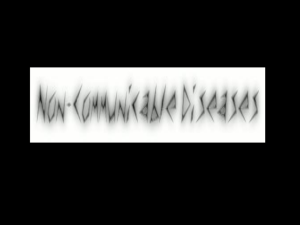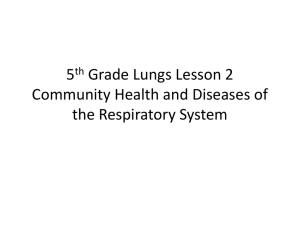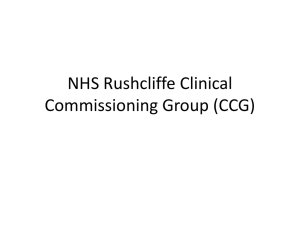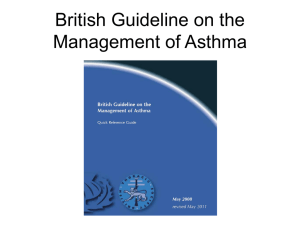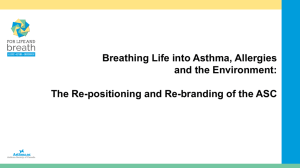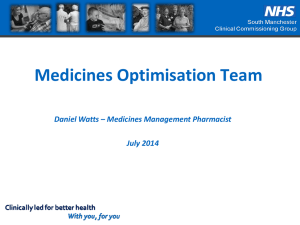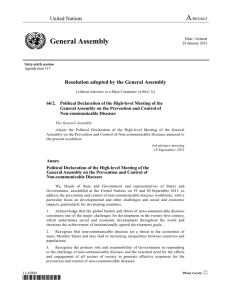Non-Communicable Diseases
advertisement
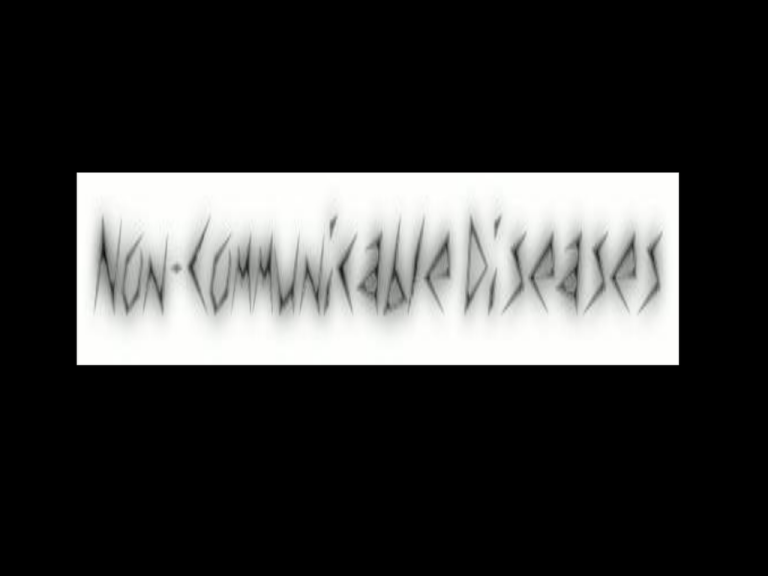
• Disease- a harmful change in the state of health of your body or mind. • Non-communicable diseases- are diseases that are NOT transmitted by pathogens • Diseases can be caused by infections, lack of nutrients, birth, or lifestyle behaviors Examples of Non-Communicable Diseases: Chronic disease- diseases that are present either continuously or off and on over a long time Degenerative disease- disease that causes breakdown in body cells, tissues, and organs as they progress • Can a chronic disease be generative? • • Sign- fever Symptom- sore throat Some diseases have several signs and symptoms. Different diseases may produce the same signs and symptoms. • It is possible to have a disease and not have symptoms • Scurvy is an ancient disease, reported as far back as 1550 B.C. It is a non-communicable disease caused by a Vitamin C deficiency. It was a major problem on long sea voyages in 1600s and 1700s when sailors did not eat fruits and vegetables. One many voyages nearly 2/3 of the crew would die. James Lind, 1747 discovered that adding lemon juices to sailors’ rations would help prevent scurvy. An estimated one million men died between 1600-1800. Scurvy is rare in developed countries. • • • • Many non-communicable diseases cannot be prevented Some are inherited from parents Some are present at birth, but are not inherited Risk factors- characteristic or behavior that raises a person’s chances of getting a non-communicable disease Risk Factors with No Control Over: Age Gender Race Risk Factors with Control Over: Amount of food Type of food Diet Smoking (risky behavior)- something that increases chance of getting a non-communicable disease Chemical waste Certain construction materials Household chemicals Secondhand smoke Improper waste disposal Radon Carbon monoxide Scientists study to find cures Most diseases caused by injury are preventable Diet and exercise can help prevention of some non-communicable diseases Not smoking or drinking can prevent some non-communicable diseases Most non-communicable diseases cannot be cured They can be treated Treatment is given to slow progress or stop the disease • News reporter and doctor, representing the risk factors and treatment options for s noncommunicable disease • Identify and describe a common noncommunicable disease. A disease caused by defective genes inherited by a child from one or both parents Caused by changes in the structure of genes Genes determine the activities of cells and a person’s physical characteristics Genes are passed from parent to child A gene change may cause a hereditary change Sickle Cell- caused by change to one gene Colon cancer- changes in more than one gene Breast cancer- changes in more than one gene Down syndrome- born with part or all of an extra 21 chromosome Doctors can test for a number of hereditary diseases This helps to reduce problems that might cause disease Example: newborns tested at birth (Tested for PKU- it can cause mental retardation. If it is caught at birth, then newborns are put on a low-protein diet and if started right away and carried throughout life, it will be prevented). Down syndrome- effects the ability to learn Cystic Fibrosis- affects trouble breathing People with hereditary diseases may experience medical problems These problems can be reduced if caught early • Process by which the body converts the energy in food into energy the body can use. • Takes places after digestion • Metabolic Diseases: PKU- happens before birth Diabetes- happens after birth Causes: Hereditary Nutrition and diet Some other causes Nutrition is extremely important- low Vitamin D may cause rickets (deformed bones), low Vitamin A (blindness) too much Vitamin A ( hair loss or liver disease) A disease that prevents the body from converting food into energy The body has to breakdown food into glucose To transport glucose cells, the body needs insulina hormone produced by the pancreas Types of Diabetes o Type 1 Diabetes- condition in which the immune system attacks insulin-producing cells in the pancreas o Type 2 Diabetes- condition in which the body cannot effectively use the insulin it produces It is more likely to occur in people 40 and over who are obese in physically inactive It is becoming more common in children and teens Diagnosing Diabetes o Frequent urination o Excessive thirst o Unexplained weight loss o Extreme hunger o Sudden vision changes o Tingling or numbness in hands or feet o Feeling tired much of the time o Very dry skin o Sores that are slow to heal o More infections that usual o It is possible to have no symptoms for years There is no known prevention for Type 1 diabetes Treatment for Type 1 involves daily injections Healthy weight and physical activity reduce the chance of developing Type 2 diabetes Type 2 involves oral medication or dietary changes Important to have a normal life- nutritious diet Proper balance of carbohydrates, fats, protein, vitamins, and minerals Poor nutrition can lead to malnutrition Eating the right amount of food is just as important as eating the right food ( need to try and get 2,000-2,500 calories a day) If you take in more energy than you use, your body stores it as fat Too much fat stored can lead to obesity Obesity is linked to heart disease, high blood pressure, some types of cancer, type 2 diabetes, and a variety of other diseases Minimize computer and TV time Don’t eat snacks while watching TV Exercise (20-30 minutes in vigorous exercise a day) An overreaction of the immune system to something in the environment that is harmless to most people Our body will react to a foreign substance by trying to weaken or eliminate the substance Part of the process is releasing antibodies, which fight foreign substances in the body Some people develop allergies- abnormal immune reaction to an ordinarily harmless substance Allergens cause allergic reactions Between 40-50 million people are affected with allergies Most common forms- food, plants, pollen, medications, mold, animals with fur or feather, insect stings, synthetic materials, poison ivy Some may affect a small portion of the body (poison ivy) or the entire body (food reactions) Stage One: Contact is Made Stage Two: Attack is Launched Stage Three: Symptoms Appear The body responds to allergens by releasing histamines- chemicals in the body that cause symptoms Common symptoms: o Watery eyes o Sneezing o Skin rash o Hives- small raised bumps on the skin that are very itchy Diagnosing is fairly easy- hives after eating peanuts, sneezing beside a cat, and many more There is no cure for allergies, just ways to cope with them Most basic way is to avoid the allergen Take antihistamines- medicines to help control the effect triggered by histamines- when you cannot avoid them Take allergy shots- these help build immunities to the body, process usually takes five years A chronic serious condition that causes air passages in the respiratory system to become blocked or narrowed More than 17 million people in the United States has asthma Some outgrow it at puberty, while others develop at adulthood Bronchial tubes are sensitive to certain substances in asthma patients Asthma triggers- smoke, pollution, foods, or medicines Cold air, strenuous activity, strong emotions, or stress can trigger attacks too Asthma triggers vary from person to person There is no cure for asthma Those with asthma learn how to manage it and live healthy lives Coping with asthma means avoiding triggers when possible There are medicines used to treat it Some medicines block swelling the bronchial tubes and decrease to reduce the amount mucus being produced Bronchodilators- are medicines used to relax the muscles that have tightened around the airways Autoimmune diseases- are diseases where a person’s immune system attacks certain cells, tissues, and organs of the body Most allergies, asthma and autoimmune diseases cannot be prevented Genetics play a role There are treatments-specific to each one • Name one way that allergies, asthma, and autoimmune diseases are similar and one way they are different. A disease in which cells grow uncontrollably and invade and destroy healthy tissues Cells die and are replaced in the body daily Sometimes cells DNA instructions get changed- the size, shape, and behavior can cause the cell to be abnormal As cells grow, they cause tumors- mass of abnormal cells Tumors may be malignant or benign Malignant- are cancerous and can be life threatening They can spread through the body, invade other organs and tissues (metastasis) , and tend to get worse Benign- are not cancerous and not usually life threatening They do not spread to other organs or tissues Cancer can affect any tissue or organ in the body Common cancers in women o Breast o Ovarian o Lung Common cancers in men o Prostate o Colon o Lung Common cancer in children o Leukemia Skin cancer is one of the most common types o Basal cell carcinoma( BCC) is the most common type o Melanoma is the most serious type • Assessing Your Health: Self-examination: • Asymmetry- look for moles or markings that are not symmetrical • Border irregularity- look for moles or markings with edges that are crooked or wavy • Color- look for markings or moles that vary in color from one area to another • Diameter- look for moles or markings that are larger than a pencil eraser 20-40 years in age have a cancer check-up every 3 years 40 and over need one yearly Heredity Lifestyle behaviors Exposure to carcinogens- substances that cause cancer Look for warning signs (pg. 486) When a warning sign is described to a doctor they will call for a biopsy A biopsy is a sample of tissue removed to see whether cancer cells are present If they are detected then the doctor will order tests to determine size and location Types of Treatment o Surgery-removing cancer cells from the body o Chemotherapy- chemicals used to destroy cancer cells o Radiation-High-radioactive substances help destroy or shrink cancer cells o Immunotherapy- used in combination with another treatment, it stimulates the body’s immune system to fight infection o Hormone therapy –cancer is treated with hormones or medicines that interfere with production of hormones When cancer signs and symptoms disappear the patient is in remission Cancer in remission is not necessarily cured The return of cancer after remission is-recurrence Eat nutritious foods Be physically active Limit sun exposure Avoid tobacco and alcohol • Create a concept map using the following terms: cancer, tumor, malignant, benign, carcinogens, biopsy, chemotherapy, radiation. Any condition that weakens the heart or blood vessels or interferes with the functions they perform More adults in the U.S. die from heart disease than anything else Depends on age, lifestyle behaviors, and hereditary Arteriosclerosis- is when arteries become hardened and become more rigid It reduces the amount of blood flow through arteries Atherosclerosis - is a form of arteriosclerosis, where fatty substances in the blood build up on walls of the arteries Buildup in coronary arteries can lead to heart attacks Build up in blood vessels can lead to stroke Blood pressure is the force of blood on the inside walls of arteries High blood pressure is when your blood pressure is consistently higher than normal for your age The top number is the pressure when the heart beats The bottom number is the pressure when the heart rests Blood pressure 140/90 is normal Heart attack- is a condition where blood flow to a part of the heart is greatly reduced or blocked ( if it is more than a few minutes then cells can be damaged and die) Signs of heart attack o Pressure, fullness, squeezing, or pain in the chest o Pain in the shoulders, neck, or arms o Chest discomfort with lightheadedness, fainting, sweating, nausea, or shortness of breath Stroke- conditions where a blood vessel bringing oxygen to the brain bursts or is blocked Signs of stroke o Sudden numbness or weakness ( on one side of body) o Sudden confusion or difficulty with speech or understanding o Sudden difficulty seeing o Sudden dizziness, or loss of balance and coordination Medication Angioplasty-putting a stint when plaque builds up in artery walls Bypass surgery- taking a healthy vein from leg or chest to put a detour around a blocked vein Heart valve surgery- replacing a faulty valve with an artificial one Pacemaker- a small device that sends steady electrical impulses to the heart to make it beat regularly Manage stress Manage weight Manage physical activity Manage poor eating habits Manage tobacco and alcohol use ***Though it is not detected until adulthood, it can develop in childhood. Start managing your health now • Three ways to prevent heart disease are…. People with arthritis have more than 100 conditions marked by pain and swelling in body joints It can affect people of any age Two most common types: rheumatoid arthritis and osteoarthritis A chronic disease caused by pain, inflammation, swelling, and stiffness of joints Most serious of the most common forms Joints become deformed and often no longer function normally Joints affected: hands, feet, elbows, shoulders, neck, knees, hips, and ankles It is usually symmetrical in the body: both hands will hurt The cause is unknown Treatment o No known treatment o Medicines to relieve pain, reduce swelling, and keep joints functioning as normal as possible o Exercise, rest, joint protection, and physical therapy are recommended Characterized by the breakdown of cartilage in joints Areas affected: hands, knees, and hips Most affected are over the age of 45 Treatment o Medication o Hot or cold therapy o Joint protection o Weight reduction on joint • Compare and contrast osteoarthritis and rheumatoid arthritis. Your environment is all of the living and non-living things around you Some parts can be harmful Chemicals are necessary and useful, but some are poison- can cause illness or death if swallowed or inhaled Some are clearly marked and some aren’t Poisons can be solids, liquids, and gases Some poisons are toxins- produced by a living organism Example-snake Air pollution-triggers asthma attacks or allergies Cigarette Smoking air- birth defects or emphysema Vinyl chloride- makes plastic products- liver cancer/brain tumors Lead in materials- effect kidneys, liver, organs, convulsions, death Learning possible dangers is the best way to avoid them Accidents are unexpected events that cause damage , injury, or death Most are minor, but some can cause traumatic injuries Traumatic injuries- are caused by physical force Head injuries (example) Injuries can cause disease Brain injury can cause- loss of memory, coordination, function of body parts, seizures and those similar to other brain diseases Do not drink alcoholic beverages Do not play with guns Always wear a helmet and other safety gear on bikes and skateboards Always wear appropriate safety gear when playing a sport Learn CPR Wear a seatbelt every time you are in the car
